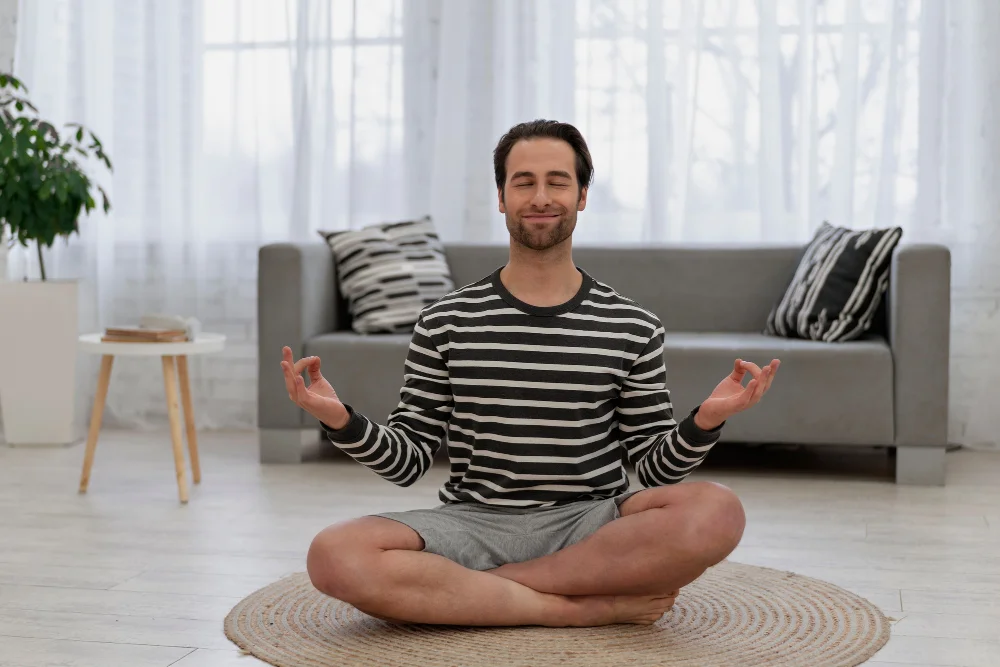Discover the transformative serenity of ‘Do Nothing Meditation’ because amid the hustle and bustle of our accelerating world, it offers a rejuvenating refuge of calm and centeredness.
Diving into the tranquil world of “do nothing” meditation, this practice invites you to simply be, allowing thoughts and sensations to come and go without interference. It’s a journey of self-discovery and inner peace, where you’re not striving to change anything about your experience.
In this article, you’ll uncover the essence of this meditation technique, its benefits, and a comprehensive guide on how to practice it. Offering a detailed exploration of this unique approach to mindfulness, this piece will provide the clarity and guidance you’re seeking.
So, let’s embark on this enlightening journey of “doing nothing” and embracing everything.
Key takeaways:
- Let go of control, observe thoughts without engagement.
- Activates prefrontal cortex, reduces anxiety.
- Releases urge to do something, allows consciousness to be.
- Reduced stress, enhanced creativity, emotional stability, self-awareness, sharpened attention.
- Start with 5 minutes, gradually increase to 15-20 minutes.
Understanding Do Nothing Meditation Technique

This form of meditation is a paradox in itself. Its essence lies in non-doing, an absorption into quiet, as opposed to active focus on a mantra, breath, or visualization, which are typical pillars of other meditation practices. It doesn’t mean turning the brain off, but rather allowing it to relax into its natural state.
In simpler terms, it’s a practice that lets you observe without engaging yourself in thoughts or impulses. Ground rules include:
- Let Go: Surrender your urge to control the direction of your self-awareness.
- Maintain Openness: Be patient and allow yourself to experience your inner world without judgments or expectations.
- Embrace Silence: Permit yourself a meandering journey into the quietude and peace deep within.
- Observe: Take a backseat and become a bystander to your own mind, experiencing thoughts, emotions, impulses, and ideas as if you were a third-party observer.
- No Goals: In “do nothing” meditation, there are no targets or results to be reached. It’s about being present in this very moment.
It’s not as easy as it sounds, but with practice, it becomes more natural and reveals insightful self-discoveries.
The Neuroscience Behind Do Nothing Meditation

Diving deep into the brain’s operation, it becomes clear that Do Nothing Meditation activates certain areas thought to regulate focus and attention. A key structure impacted is the prefrontal cortex, responsible for executive functions such as self-control and decision-making. During this form of meditation, the brain waves transition to a phase known as alpha. These waves signify a relaxed, yet aware state, promoting creativity and reducing anxiety.
Additionally, the amygdala, our fear and anxiety control center, displays lessened activity. It’s turned down, so to speak, providing a sensation of calm and tranquillity. Moreover, enhanced connectivity between the amygdala and the prefrontal cortex leads to improved emotional regulation.
Also noteworthy is the activity in the default mode network (DMN), which includes the medial prefrontal cortex and the posterior cingulate cortex. These areas are active when we let our minds wander or engage in self-referential thoughts. During Do Nothing Meditation, the activity in the DMN reduces, helping to anchor us in the present, diminishing the straying of the mind.
Finally, the practice stimulates the hippocampus, playing a part in memory processing and emotional responses, encouraging a sense of peace and enhanced retention abilities.
How Do Nothing Meditation Works

This unique form of meditation revolves around the art of simply existing, without actively trying to change or analyze our state of mind. These points explicate the concepts behind it:
- Release Control: Instead of focusing or directing the mind, one simply lets go of control. It’s natural for thoughts to arise – the key is not to interact with them.
- Non-Action: It emphasizes non-doing or non-action. One refrains from making any conscious decision to move, think or react.
- Witness Consciousness: The practitioner notices experiences without reacting. Like a mirror reflecting images without judgement or preference.
- Allowing Whatever Comes: There’s no preferred state of mind. Rather than aiming for peace or enlightenment, allow all thoughts and feelings to surface.
- Lack of Technique: Unlike other forms of meditation, there’s no technique to master, making it accessible to everyone, everywhere.
Benefits of Practicing Do Nothing Meditation

Immersing yourself in this meditation method may deliver a unique set of advantages:
1. Reduced Stress: By letting your mind wander freely, without focusing on any single thought or sensation, you can achieve profound relaxation, which helps in mitigating stress levels.
2. Enhanced Creativity: The freeing concept of do nothing meditation can stimulate fresh ideas, allowing you to tap into the creativity that a busy, often distracted mind may suppress.
3. Promotes Emotional Stability: As you let thoughts flow without judgment or attachment, you can foster emotional equanimity, learning to experience emotions without being overwhelmed.
4. Increased Self-awareness: The practice aids in offering insights into your habits and thought processes, fostering a greater understanding of yourself.
5. Sharpens Attention: Although it might seem contradictory, ‘doing nothing’ can improve your ability to focus when needed, as you train your mind to be present and relaxed instead of forcing concentration.
Remember, each individual’s experience with Do Nothing Meditation can vary greatly. You may experience other benefits unique to your mind and body. These five points cover the most commonly perceived benefits.
Addressing Challenges and Finding Solutions in Do Nothing Meditation

While Do Nothing meditation seems simple, it isn’t devoid of challenges. One major hurdle is the mind’s constant chatter, leading to a whirlpool of thoughts. Overcoming this can be achieved by simply being a silent observer to these thoughts, acknowledging their existence, then letting them go, essentially doing nothing about them. It’s paramount not to suppress or engage with these thoughts, which only fuels their power.
Another challenge is the predisposition to measure progress or reach a specific outcome, often leading to frustration. The solution lies in recognizing that this meditation’s primary aim is the process itself, not the outcome. Embrace each session as a fresh experience rather than a step towards a goal.
Physical discomfort can also pose a challenge during practice. Starting with shorter sessions and gradually increasing the duration can help navigate through this. Additionally, opting for a comfortable position or using props can alleviate physical strains.
Remember, the essence of this meditation lies in its name; ‘Doing Nothing‘ is precisely what’s required. So, treat these hurdles not as interruptions, but part of the journey itself, embracing the very challenges that make the technique unique and beneficial.
Contrasting Mindfulness and Do Nothing Meditation

In essence, mindfulness meditation emphasizes active engagement with and observation of the mind’s activity. It’s guided by the principle of acknowledging thoughts and feelings, examining them without judgment, then letting them go.
On the other hand, Do Nothing meditation, as the name implies, encourages the practitioner to simply exist. It’s about complete surrender, where thoughts and feelings are neither encouraged nor resisted. The focus is on releasing the constant urge to do something and allowing consciousness to be, unfettered and free.
While mindfulness asks you to be a silent spectator of your mind’s movie, Do nothing meditation asks you to step out of the theater altogether. Both techniques, while distinct, have their unique benefits and can complement each other when practiced together.
Recommended Duration for Practicing Do Nothing Meditation

The time investment in this meditation technique varies greatly depending on personal comfort and daily time constraints. For beginners, starting with just five minutes daily can establish a strong foundation. As familiarity and comfort with the practice grow, gradually extend the duration up to 15-20 minutes. Consistency is paramount. It is advisable to proceed at a pace that one can sustain and consistently incorporate into their routine.
While it might be tempting to extend the duration in the belief of proportionally larger benefits, moderation is key. A balance should be struck, keeping in mind that this technique encourages relaxation, not strain. A mindful approach would be to listen to one’s body and mind, recognizing and respecting individual limits.
It is also noteworthy to consider creating a conducive environment. Minimize potential distractions to maintain a tranquil space, aiding in longer periods of concentrated practice. Remember, it is not about achieving a record duration but about practicing consistently with the right technique and mindset.
Practical Training Techniques for Do Nothing Meditation

Beginning your session, find a quiet space with minimal distractions. Position yourself comfortably, either on a chair or a meditation mat. Maintain good posture, keeping your back straight and shoulders relaxed.
Next, softly close your eyes, inhale deeply and gently exhale, beginning your journey into stillness. You may find it tempting to adopt certain meditation techniques, but resist this urge. The essence of do nothing meditation is devoid of formal practices.
Sensations will naturally arise. Acknowledge them without engaging. If thoughts pop up, allow them to flow freely, without attaching or creating narratives. You’re simply a neutral observer, no task to perform or problem to solve.
It’s okay if your mind wanders; this is not a concentration exercise. The key point is allowing everything to be as it is, no manipulation.
And finally: patience. Adapting to this technique may take time. There’s no rush, no expectations. Practice consistently, and embrace the subtle shifts within your consciousness.
FAQ
Does doing nothing count as meditation?
Yes, doing nothing can be considered a form of meditation, specifically known as do nothing meditation, if it is done purposefully and mindfully.
What is the meditation state of nothingness?
The meditation state of nothingness is a mental space achieved when the individual’s sense of self, or “I,” has fully dissolved, leading to an experience of profound emptiness or void.
Why is silent meditation good?
Silent meditation is beneficial because it enhances calmness, clarity, and acceptance, allowing an objective observation of the flow and change in life, while fostering a deeper understanding of life’s inherent qualities.
How does ‘Do Nothing’ Meditation improve mental health?
‘Do Nothing’ Meditation improves mental health by providing a break for the mind, reducing stress, and enhancing focus, thus promoting a more serene and mindful existence.
What are the primary steps to practice ‘Do Nothing’ Meditation?
The primary steps to practice ‘Do Nothing’ Meditation involve finding a quiet and comfortable place, sitting in a relaxed posture, closing your eyes, letting go of any attempt to control your thoughts and simply observing your mind’s activity without engagement or judgment.
Can ‘Do Nothing’ Meditation increase productivity and focus?
Yes, ‘Do Nothing’ Meditation can increase productivity and focus by allowing the mind to naturally settle into calmness, which translates into improved concentration and efficiency in tasks.